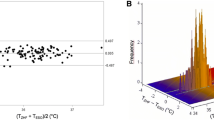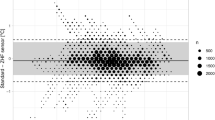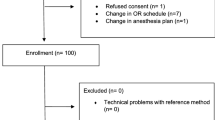Abstract
An accurate determination of body core temperature is crucial during surgery in order to avoid and treat hypothermia, which is associated with poor outcome. In a prospective observational study, we evaluated the suitability of the Tcore™ device (Drägerwerk AG & Co. KGaA, Lübeck, Germany)—a non-invasive thermometer—to accurately determine core body temperature. In patients undergoing surgery for ovarian cancer, core body temperature (CBT) was determined with the Tcore™ sensor attached to the forehead and compared with blood temperature (Tblood) as measured within the femoro-iliacal artery. Both temperatures were recorded every 10 s and the measurement error was calculated. 57,302 data pairs of CBT and Tblood were obtained in 22 patients. In a repeated-measurements version of the Bland and Altman test, a bias of − 0.02 °C and 95% limits of agreement of − 0.48 to 0.44 °C were calculated. In a population analysis, a median absolute error of 0 [− 0.1; + 0.1] °C, a bias of 0 [− 0.276; 0.271] % and an inaccuracy of 0.276 [0.274; 0.354] % was determined. Although the Tcore™ sensor was attached to the frontal skin, it provided an accurate measurement of core body temperature in the investigated intraoperative setting.





Similar content being viewed by others
References
Sessler DI. Perioperative thermoregulation and heat balance. Lancet. 2016;387(10038):2655–64.
Rajagopalan S, Mascha E, Na J, Sessler DI. The effects of mild perioperative hypothermia on blood loss and transfusion requirement. Anesthesiology. 2008;108(1):71–7.
Kurz A, Sessler DI, Lenhardt R. Perioperative normothermia to reduce the incidence of surgical-wound infection and shorten hospitalization. Study of Wound Infection and Temperature Group. N Engl J Med. 1996;334(19):1209–15.
Krizanac D, Stratil P, Hoerburger D, Testori C, Wallmueller C, Schober A, Haugk M, Haller M, Behringer W, Herkner H, Sterz F, Holzer M. Femoro-iliacal artery versus pulmonary artery core temperature measurement during therapeutic hypothermia: an observational study. Resuscitation. 2013;84(6):805–9.
Gunga H-C, Sandsund M, Reinertsen RE, Sattler F, Koch J. A non-invasive device to continuously determine heat strain in humans. J Therm Biol. 2008;33:297–307.
Kimberger O, Thell R, Schuh M, Koch J, Sessler DI, Kurz A. Accuracy and precision of a novel non-invasive core thermometer. Br J Anaesth. 2009;103(2):226–31.
Kimberger O, Saager L, Egan C, Sanchez IP, Dizili S, Koch J, Kurz A. The accuracy of a disposable noninvasive core thermometer. Can J Anaesth. 2013;60(12):1190–6.
Klaschik S, Gehlen J, Neumann C, Keyver-Paik MD, Soehle M, Frede S, Velten M, Hoeft A, Hilbert T. Network of mediators for vascular inflammation and leakage is dysbalanced during cytoreductive surgery for late-stage ovarian cancer. Mediators Inflamm. 2019;2019:5263717.
Zivanovic O, Abramian A, Kullmann M, Fuhrmann C, Coch C, Hoeller T, Ruehs H, Keyver-Paik MD, Rudlowski C, Weber S, Kiefer N, Poelcher ML, Thiesler T, Rostamzadeh B, Mallmann M, Schaefer N, Permantier M, Latten S, Kalff J, Thomale J, Jaehde U, Kuhn WC. HIPEC ROC I: a phase I study of cisplatin administered as hyperthermic intraoperative intraperitoneal chemoperfusion followed by postoperative intravenous platinum-based chemotherapy in patients with platinum-sensitive recurrent epithelial ovarian cancer. Int J Cancer. 2015;136(3):699–708.
Bland JM, Altman DG. Agreement between methods of measurement with multiple observations per individual. J Biopharm Stat. 2007;17(4):571–82.
Eshraghi Y, Nasr V, Parra-Sanchez I, Van Duren A, Botham M, Santoscoy T, Sessler DI. An evaluation of a zero-heat-flux cutaneous thermometer in cardiac surgical patients. Anesth Analg. 2014;119(3):543–9.
Kimberger O, Cohen D, Illievich U, Lenhardt R. Temporal artery versus bladder thermometry during perioperative and intensive care unit monitoring. Anesth Analg. 2007;105(4):1042–7.
Moran JL, Peter JV, Solomon PJ, Grealy B, Smith T, Ashforth W, Wake M, Peake SL, Peisach AR. Tympanic temperature measurements: are they reliable in the critically ill? A clinical study of measures of agreement. Crit Care Med. 2007;35(1):155–64.
Gunga HC, Werner A, Stahn A, Steinach M, Schlabs T, Koralewski E, Kunz D, Belavy DL, Felsenberg D, Sattler F, Koch J. The Double Sensor-A non-invasive device to continuously monitor core temperature in humans on earth and in space. Respir Physiol Neurobiol. 2009;169(Suppl 1):63–8.
Sessler DI. Temperature monitoring and perioperative thermoregulation. Anesthesiology. 2008;109(2):318–38.
Wartzek T, Muhlsteff J, Imhoff M. Temperature measurement. Biomed Tech (Berl). 2011;56(5):241–57.
Sastre JA, Pascual MJ, Lopez T. Evaluation of the novel non-invasive zero-heat-flux Tcore thermometer in cardiac surgical patients. J Clin Monit Comput. 2019;33(1):165–72.
Gomez-Romero FJ, Fernandez-Prada M, Fernandez-Suarez FE, Gutierrez-Gonzalez C, Estrada-Martinez M, Cachero-Martinez D, Suarez-Fernandez S, Garcia-Gonzalez N, Picatto-Hernandez MD, Martinez-Ortega C, Navarro-Gracia JF. Intra-operative temperature monitoring with two non-invasive devices (3M Spoton(R) and Dräger Tcore (R)) in comparison with the Swan--Ganz catheter. Cir Cardiov. 2019;26(4):191–6.
Boisson M, Alaux A, Kerforne T, Mimoz O, Debaene B, Dahyot-Fizelier C, Frasca D. Intra-operative cutaneous temperature monitoring with zero-heat-flux technique (3M SpotOn) in comparison with oesophageal and arterial temperature: a prospective observational study. Eur J Anaesthesiol. 2018;35(11):825–30.
Acknowledgements
The complimentary provision of Tcore™ sensors by the manufacturer, Drägerwerk AG & Co.KGaA, Lübeck, Germany is gratefully acknowledged. The manuscript contains part of the doctoral thesis of HD.
Author information
Authors and Affiliations
Corresponding author
Ethics declarations
Conflict of interest
SZ has received consultancy fees and travel reimbursement from Drägerwerke AG & Co. KGaA in the past on projects unrelated to the investigated device. This study did not receive any support from the manufacturer other than provision of the device and disposable materials free of charge.
Ethical approval
All procedures performed in studies involving human participants were in accordance with the ethical standards of the institutional and/or national research committee and with the 1964 Helsinki declaration and its later amendments or comparable ethical standards.
Informed consent
Informed consent was obtained from all individual participants included in the study.
Rights and permissions
About this article
Cite this article
Soehle, M., Dehne, H., Hoeft, A. et al. Accuracy of the non-invasive Tcore™ temperature monitoring system to measure body core temperature in abdominal surgery. J Clin Monit Comput 34, 1361–1367 (2020). https://doi.org/10.1007/s10877-019-00430-9
Received:
Accepted:
Published:
Issue Date:
DOI: https://doi.org/10.1007/s10877-019-00430-9




